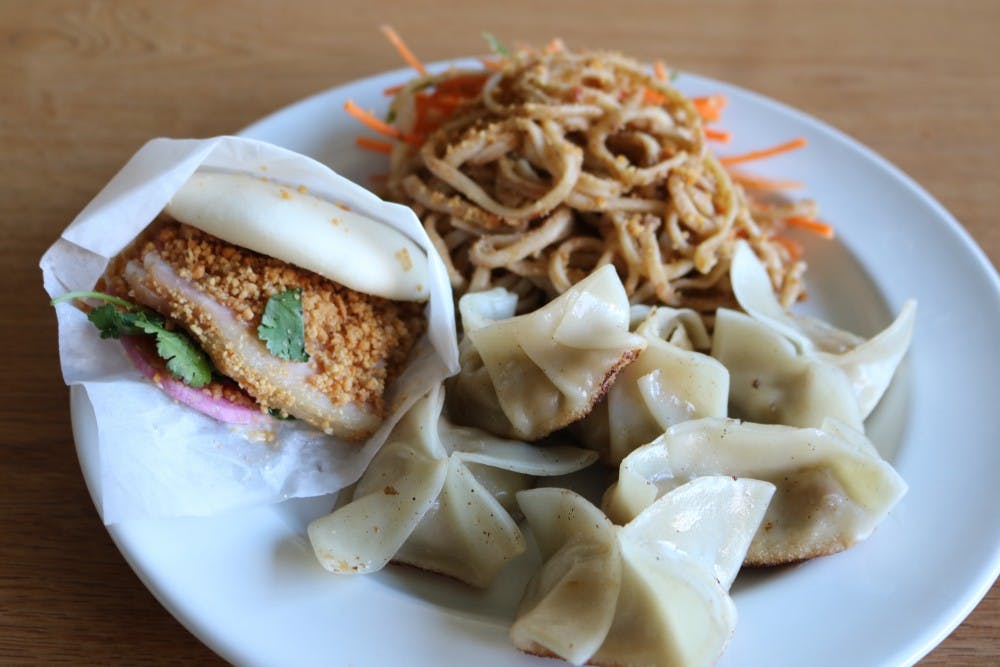After a quick ten–minute mid–afternoon walk from the Rodin Museum, I found myself strolling into the recently established Bao–logy. I was greeted by a bright, sleek interior with a kiosk ordering system similar to Honeygrow's. The restaurant, marketing itself as specializing in “modern Taiwanese street food," opened only this past June, but owners Judy Ni and Andrew Tessier are no newcomers to the food industry. Before Bao–logy, the husband and wife duo specialized in the farm–to–table culinary approach with their previous restaurants The Farm & Fisherman and Blue Hill at Stone Barns.
Ni, inspired by her family’s efforts to cook with the highest quality ingredients (usually the produce growing in their own backyard) and the street food culture in Taiwan, came up with the concept for the new restaurant. Tessier and Ni’s devotion to fresh ingredients is apparent: all food is made on site, and kitchen staff even come in before hours to prepare the ingredients (which are always kept on low inventory to ensure quality). The street food facet of the restaurant is reflected in the portable packaging of each dish. The name Bao–logy comes from the Taiwanese word "bao" meaning, bun, package, or something wrapped. This theme is seen in not only the presentation of the food but also the actual menu items themselves, with most dishes prepared wrapped in dough, buns, or thin spring roll wrapping.

Menu items focus on variations of three dishes: potstickers, gwa baos, and ruen bings. Options such as Bao–logy’s “com bao” and “bian dang” give customers the ability to sample all three specialties. The potstickers, which are wrapped in thin dough made on site fresh every morning, come in portions of three, six, or nine ($3.50–$9.50) with the option to mix and match shrimp, pork, chicken, and vegetables. I went for the pork and shrimp potstickers and was pleased by the texture of the crisp seared bottoms and the soft steamed tops of the dumplings as well as the surprisingly harmonious pairings of the two forms of protein. "Gwa baos" ($3.75) are sweet fluffy buns stuffed with a variety of fillings. I went for the traditional pork belly gwa bao and was stunned by the amount of flavor in what appeared to be a simple dish. The meat filling is slow–roasted in togarashi aioli and paired with pickles and peanut powder. The third specialty, "ruen bings" ($4.25) are large spring rolls jam packed with carrots, cabbage, shiitake mushrooms, garlic chives, hoisin sauce, peanut powder, and the customer’s choice of protein. I found the ruen bings to be the most filling item on the menu, especially because the diverse range of flavors packed into the spring roll make for a hearty experience. Each menu item has a vegetarian option.
When asked more about the methodology behind the “modern Taiwanese street food” concept, Ni explained that including the word “modern” was deliberate because Taiwanese food is constantly evolving and extremely specific to its place in the country’s history. As a nation that has been subjected to foreign occupations and influences such as the Dutch, Spanish, and Japanese, Taiwan is ever–shifting in incorporating foreign culinary styles. This can be seen in the menu’s “bian dings,” which are a Taiwanese twist on the traditional Japanese bento box. The cultural specificity of Taiwanese cuisine is also exemplified in the street food tradition, in which each vendor specializes in a singular dish. As Ni explained, although the menu may seem simple, it actually represents over a dozen different street vendors, with each item reflecting a particular vendor’s specialty.

Bao–logy's cuisine aims to break from the expectations and stereotypes customers might have regarding Asian food. Ni and Tessier were concerned that customers' assumptions about what Taiwanese food should be would overshadow the nuance and cultural specificity of what their restaurant had to offer. Although the menu encourages you to make cross cultural comparisons with item descriptions relating ruen bings to mini burritos and gwa baos to hamburger sliders, Ni and Tessier more than anything aim to expose customers to the diversity of Asian food and to ensure Taiwanese cuisine is experienced without bias.
Although portions are generally small, the complexity of the flavors and the quality of the ingredients still make for a quality, filling meal. As Ni explained, Bao–logy offers menu items that are like “fine wine” in their ability to hit a variety of flavor notes. The best way to go about navigating the menu is to opt for the different combination such as the com–bao (including an order of potstickers, gwa bao, and ruen bing), the gwa bao trio, or the potsticker trio. I definitely recommend bringing a friend and splitting the potsticker trio. My personal favorite menu item was the pork belly gwa bao, and I can definitely foresee myself biking into Center City just to get a trio.
What I found most amazing about Bao–logy, aside from the pork belly gwa baos, was how what seems like an ordinary menu actually is a narrative of Taiwanese culture and history. Bao–logy invites customers to look past generalized assumptions about different global cuisines in order to appreciate the nuances and cultural specificities each country’s food has to offer. Come to Bao–logy for a course of Taiwanese modern street food, as well as a course in Taiwanese history.







